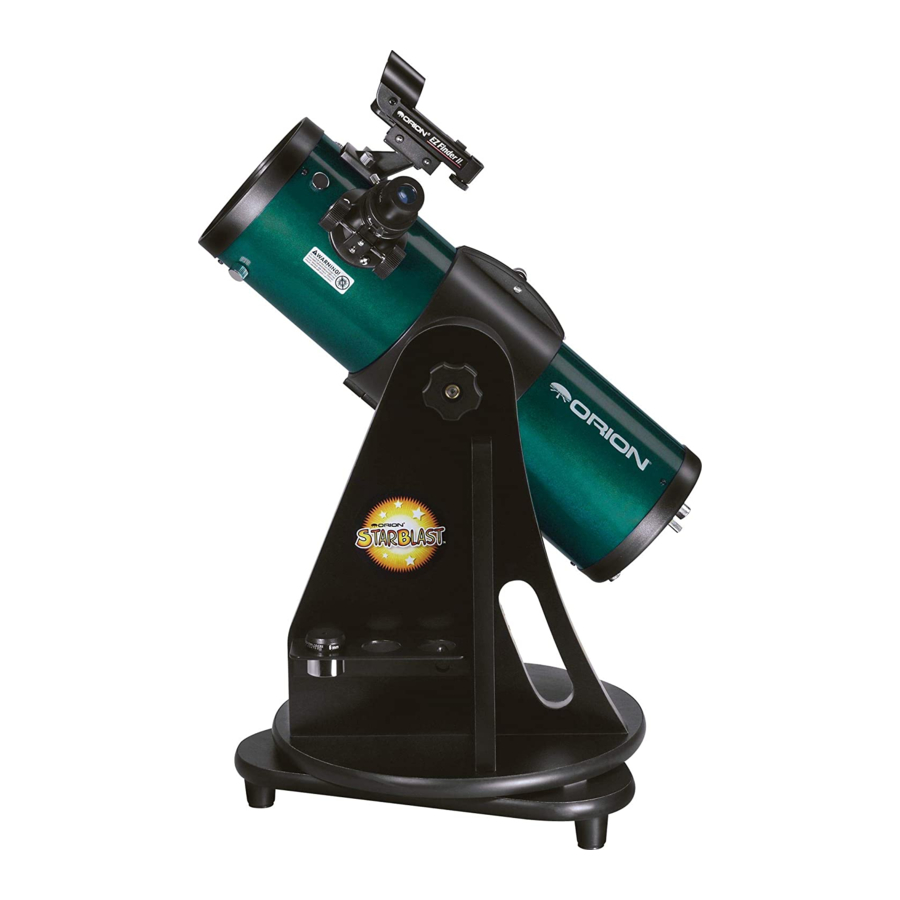
Orion StarBlast 4.5 Instruction Manual
Hide thumbs
Also See for StarBlast 4.5:
- User manual (20 pages) ,
- Instruction manual (19 pages) ,
- Instruction manual (9 pages)
Subscribe to Our Youtube Channel
Summary of Contents for Orion StarBlast 4.5
- Page 1 Syosset Public Library 225 South Oyster Bay Road Syosset, NY 11791 516.921.7161 ● www.syossetlibrary.org Syosset Public Library Orion StarBlast 4.5" Telescope INSTRUCTION MANUAL...
- Page 2 WARNING: Never look directly at the Sun through the telescope or its finder scope — even for an instant — or permanent eye damage could result. Do not point the telescope at the Sun, as parts will melt! Children should use this telescope ONLY with adult supervision.
- Page 3 Telescope Parts 1) Eyepiece (replaced with zoom eyepiece 8 to 24 mm – glued in) 2) EZ Finder Scope (remember to turn off when not in use) 3) Telescope tube 4) Focuser 5) Tube Clamp 6) Altitude Clamp (please do not turn this) 7) Mirror Assembly (please do not turn these screws) 8) Support...
- Page 4 Transporting the Telescope The easiest way to carry the telescope is to place your forearm under the telescope tube when it is in a level position, and lift, holding the upright support against your side. When in a car, simply place the telescope on a seat and use a seatbelt to secure it. The lap belt goes across the base, and the chest belt should cross the tube.
- Page 5 Care and Maintenance Don’t. Let the Librarian know if Regarding cleaning the lenses or mirrors: they seem dirty. Please do not touch the surface of the mirrors (inside the tube) or the eyepiece lens. Just touching these items will cause damage. Again, please don’t.
- Page 6 Getting Started Telescope should be placed on a flat, stable surface such as a table or park bench. Please read the instructions and practice with the telescope inside before you take it out in the dark. The image will be much better if you let the telescope cool down to air temperature before you start observing.
- Page 7 This is important enough to say again: WARNING: Never look directly at the Sun through the telescope or its finder scope — even for an instant - as permanent eye damage could result. This is one of the few really bad things you can do to yourself with this telescope. Young children should use this telescope ONLY with adult supervision.
- Page 8 Operating the Finder Scope The finder scope has a wider field of view than the telescope so that it is easier to find what you want to see. Turn on the finder scope by turning the knob on the right side.
- Page 9 Objects to Observe: The Moon is one of the easiest and most interesting targets to view with the telescope. Lunar craters, “seas”, and even mountain ranges can all be clearly seen from an average distance of 238,000 miles away! With its ever-changing phases, you’ll get a new view of the Moon every night it’s up.
- Page 10 When to go observing: “Seeing” and Transparency: Atmospheric conditions vary significantly from night to night. “Seeing” refers to the steadiness of the Earth’s atmosphere at a given time. In conditions of poor seeing, atmospheric turbulence causes objects viewed through the telescope to “boil”. In conditions of good seeing, star twinkling is minimal and images appear steady in the eyepiece.
- Page 11 WARNING: Never look directly at the Sun through the telescope or its finder scope — even for an instant — or permanent eye damage could result. Do not point the telescope at the Sun, as parts will melt! Children should use this telescope ONLY with adult supervision.

















Need help?
Do you have a question about the StarBlast 4.5 and is the answer not in the manual?
Questions and answers